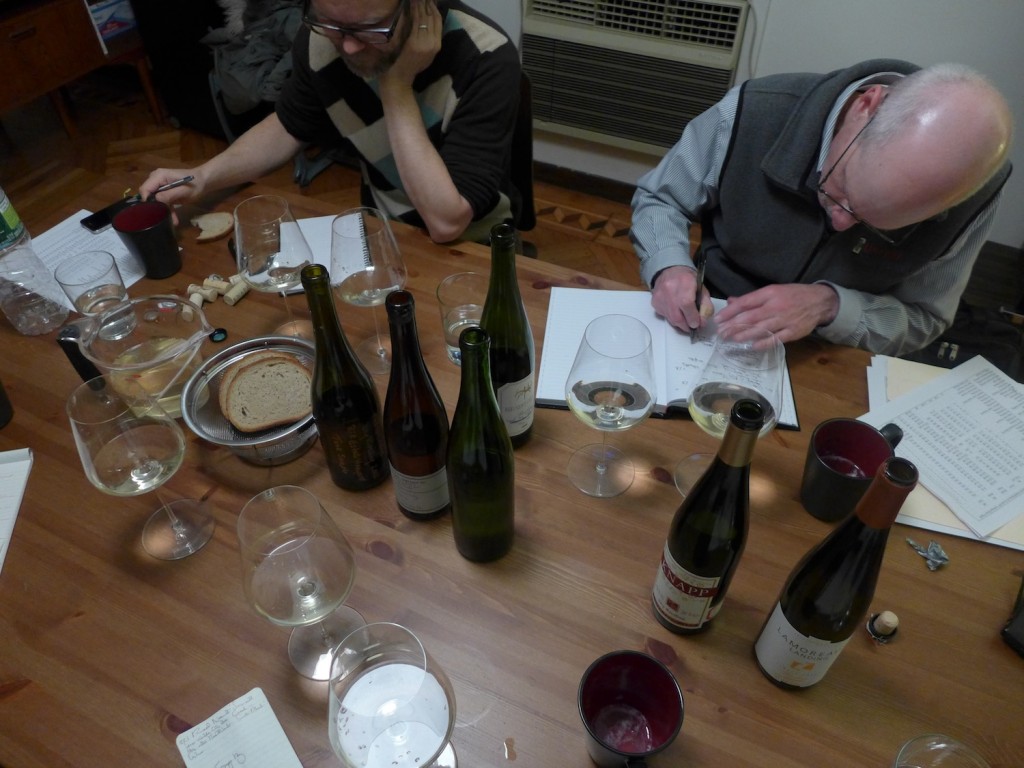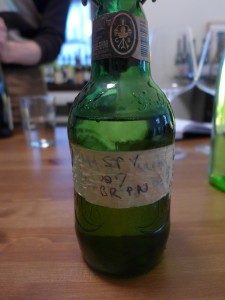 Those of you who think that tasting wine is some kind of holiday camp should examine the picture above of the Riesling Boot Camp I attended yesterday afternoon! Thanks to Bob Madill of Sheldrake Point winery in New York State’s Finger Lakes (FLX) I’ve been following the region’s Rieslings very closely recently. Since the summer of 2010 Bob Madill’s organized half a dozen comparative tastings of current Rieslings from this beautiful region which celebrated 50 years of Riesling wine production (at the Dr. Konstantin Frank winery) last year. The latest of these took place yesterday afternoon at the Hotel of Hope on East 7th Street in Manhattan’s East Village (pictured above) and focused on the 2012 vintage, most of which isn’t bottled. In spite of that fact the tasting left little doubt that 2012 is a great vintage for FLX Riesling. However, it isn’t just a great vintage because nature smiled and the grapes were both ripe and clean, rather because nature smiled and many producers have thought and worked really hard to improve their wine growing and winemaking techniques. Whether dry (less austere than before), medium-dry (a growing segment!) or frankly sweet (ever more seldom), the 2012 Rieslings are the best balanced and most elegant wines I’ve yet tasted from the FLX.
Those of you who think that tasting wine is some kind of holiday camp should examine the picture above of the Riesling Boot Camp I attended yesterday afternoon! Thanks to Bob Madill of Sheldrake Point winery in New York State’s Finger Lakes (FLX) I’ve been following the region’s Rieslings very closely recently. Since the summer of 2010 Bob Madill’s organized half a dozen comparative tastings of current Rieslings from this beautiful region which celebrated 50 years of Riesling wine production (at the Dr. Konstantin Frank winery) last year. The latest of these took place yesterday afternoon at the Hotel of Hope on East 7th Street in Manhattan’s East Village (pictured above) and focused on the 2012 vintage, most of which isn’t bottled. In spite of that fact the tasting left little doubt that 2012 is a great vintage for FLX Riesling. However, it isn’t just a great vintage because nature smiled and the grapes were both ripe and clean, rather because nature smiled and many producers have thought and worked really hard to improve their wine growing and winemaking techniques. Whether dry (less austere than before), medium-dry (a growing segment!) or frankly sweet (ever more seldom), the 2012 Rieslings are the best balanced and most elegant wines I’ve yet tasted from the FLX.
 The rate of progress since that first tasting of 2009s and 2008s has been brisk, and a good part of the credit must go to Bob Madill (pictured right at Restaurant Hearth after the tasting) for repeatedly nudging so many of his colleagues and asking them so many awkward questions about winemaking details. No doubt the critical and market success of the Dr. Konstantin Frank and Hermann J. Wiemer wineries has also played an important role, demonstrating with great clarity how the combination of high quality, fair prices and professional marketing can generate excitement for the region’s Rieslings. There has also been a growing openness for the FLX wines as a whole here in New York Wine City (NYWC). And these are just the most obvious factors which have conspired to create such a favorable situation for the reception of the 2012 FLX Rieslings.
The rate of progress since that first tasting of 2009s and 2008s has been brisk, and a good part of the credit must go to Bob Madill (pictured right at Restaurant Hearth after the tasting) for repeatedly nudging so many of his colleagues and asking them so many awkward questions about winemaking details. No doubt the critical and market success of the Dr. Konstantin Frank and Hermann J. Wiemer wineries has also played an important role, demonstrating with great clarity how the combination of high quality, fair prices and professional marketing can generate excitement for the region’s Rieslings. There has also been a growing openness for the FLX wines as a whole here in New York Wine City (NYWC). And these are just the most obvious factors which have conspired to create such a favorable situation for the reception of the 2012 FLX Rieslings.
Which wines stood out? Well, my sympathy for the underdog means that I first have to congratulate Lakewood Vineyards on the best wines I ever tasted from them. Their 2012 ‘3 Generations Dry’, regular ‘Dry’ and medium-sweet wines are a quantum leap up in concentration and sophistication, propelling them into the leading group of FLX Riesling producers. The leap for Bellwether is less dramatic, but they too have probably made their best wines to date and these were probably the most minerally wines in the tasting. I was expecting Dr. Konstantin Frank’s wines – ‘Dry’ and ‘Semi-Dry’ – to be impressively vivid and aromatic, elegant and racy, which they indeed were. Their blackcurrant note is something which you either like (it’s certainly attractive for me) or you don’t (it could remind you of Sauvignon Blanc). Each of Red Newt’s five single vineyard designated wines were completely distinctive, the balance being spot on wether they had 6 grams/liter of residual sweetness – Tango Oaks Vineyard – or 60 grams/liter RS – the stunning Sawmill Creek ‘North Block’. In the latter style the ‘Late Harvest’ from Fox Run stood out for its fine honey character (from noble rot) and elegant harmony. The three medium-dry vineyard designated wines and the regular ‘Dry’ Riesling from Lamoreaux Landing (the last of these a steal at $13.99 on the shelf – when it gets there) combined power with elegance, and will surely develop beautifully for many years to come.
 As Bob Madill pointed out, the packaging for Sheldrake Point’s experimental 2012 ‘Barrel Fermented’ dry Riesling is, “edgy”. I mean, I’ve seen some wine labels that looked like torn off pieces of paper before, but combining this with reused Grolsch lager bottles is really pushing the envelope out a long way! The wine (still a cask sample) tastes like no other FLX Riesling I so far encountered. Muscular and richly textural, it tastes remarkably supple considering its healthy acidity content due to its long maturation on the lees and only has the merest hint of oak (the barrel had been sued for Chardonnay since 2003). Although it was the most yeasty wine in the tasting and still quite cloudy, I felt I could confidently predict what will happen to the regular 2012 ‘Dry’ Riesling from Sheldrake Point. With its intense lime -lemon aromas and considerably concentration, this is surely the winery’s best showing to date. However, that’s a comment I can extend to almost all the FLX Rieslings I tasted yesterday and that extends all the way to the big Wagner winery. I can’t wait to taste the 2012 wines from Anthony Road, Ravines and Hermann J. Wiemer which were not included in the tasting. However, I feel sure that they would only have underlined that this is going to be a big year for the FLX!
As Bob Madill pointed out, the packaging for Sheldrake Point’s experimental 2012 ‘Barrel Fermented’ dry Riesling is, “edgy”. I mean, I’ve seen some wine labels that looked like torn off pieces of paper before, but combining this with reused Grolsch lager bottles is really pushing the envelope out a long way! The wine (still a cask sample) tastes like no other FLX Riesling I so far encountered. Muscular and richly textural, it tastes remarkably supple considering its healthy acidity content due to its long maturation on the lees and only has the merest hint of oak (the barrel had been sued for Chardonnay since 2003). Although it was the most yeasty wine in the tasting and still quite cloudy, I felt I could confidently predict what will happen to the regular 2012 ‘Dry’ Riesling from Sheldrake Point. With its intense lime -lemon aromas and considerably concentration, this is surely the winery’s best showing to date. However, that’s a comment I can extend to almost all the FLX Rieslings I tasted yesterday and that extends all the way to the big Wagner winery. I can’t wait to taste the 2012 wines from Anthony Road, Ravines and Hermann J. Wiemer which were not included in the tasting. However, I feel sure that they would only have underlined that this is going to be a big year for the FLX!
PS – an important note to FLX winemakers
The wines I tasted were almost all tank samples, which means that it is still possible to do something to them before bottling. I strongly recommend that the following not be done: 1) knocking the natural carbon dioxide out of the wines, 2) chemical deacidification of wines with ripe flavors, 3) bottling with more than 45 mg/liter free sulfur dioxide under crop or more than 40 mg/liter free sulfur dioxide under screw caps. One or two dry wines in this tasting were perhaps a little too austere. The simplest method for dealing with this is blending to lift the RS be a few grams/liter.

![120114_riesling_global_RZ [1600x1200]](http://www.stuartpigott.de/wp-content/uploads/2013/03/120114_riesling_global_RZ-1600x120010.jpg)